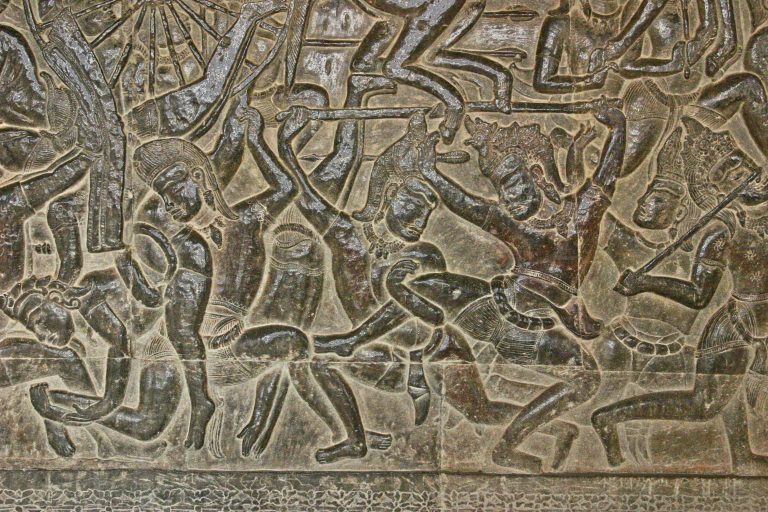Timeline of the Grand Trunk Road
Prehistory and the Vedic Period (≥ c.500 B.C.E.)
Prehistory (≥1500 B.C.E.)
The exact origin of the route which would become the GT road has been lost to history, shrouded by countless centuries that have condemned the survival of a vast majority of the road’s historic sites to literary sources.
Before its first recorded reference around 500 B.C.E by the Indian grammarian Panini, the Uttarapatha, or “Northern Road,” would most likely have been as a transport network used by humans to enter and exit the northern part of the subcontinent from Central Asia. This exchange would influence the emerging river valley cultures of the Indo-Gangetic valley and introduce the first ox-cart driven land trade routes out of India into Turkmenistan and the Iranian Plateau. This was confirmed by the uncovering of 11 burial mounds containing individuals of South Asian populations dating to around 2500-2000 B.C.E in Gonur Depe, Turkmenistan, and Shahr-i-Sokhta, Iran. These finds demonstrate a far-reaching trade network within south and central asia, formed around cosmopolitan elements only possible through the Uttarapatha.
The ruins of some of the oldest societies in the world had population centers along the Uttarapatha, and the few surviving ruins of these early cities can still be found along the GT road. Sites like Sinauli in Haryana contain some of the subcontinent’s first examples of animal-driven carriages and grave complexes less than 20 kilometers away from the modern highway.






Vedic Period (c.1500 B.C.E.- c.500 B.C.E.)
India’s Vedic period saw the emergence of Mahajanapadas (small kingdoms) and some of the world’s most prominent religions in the wake of the collapse of the Indus Valley civilizations in modern-day Pakistan. Brahamism and Vedicism took hold in these Mahajanapadas, spreading along the Uttarapatha and the subcontinent while creating epics like the Vedas, whose oldest text, the Rig Veda, documents a great battle that is believed to have occurred at Kurukshetra, Haryana, on the modern GT road.
Little remains of the era’s infrastructure along the Uttarapatha, but Vedic and Hindu texts reference the creation of three important cities in the period: Āsandīvat(now called Assandh in the state of Haryana), Indraprastha(now Delhi), and Hastinapura in Uttar Pradesh, all of which except Hastinapura lie near or directly on the modern Grand Trunk road. By the end of the Vedic period, the Maghada kingdom would emerge victorious among the Mahajanapadas and even encounter the Persian Achaemenid Empire and its royal roads and trade networks. This cultural encounter between the Persians and the Indians led to cultural and technological exchange as trade occurred across the Gangetic valley. The connection would enable distinctly Persian architectural features like columns and audience halls called Apadanas to spread into the subcontinent. In return, Indian trade goods made their way to the west along the Achaemenid’s Great Khorasan royal road, enabling new economic prosperity in the subcontinent as Indian ivory and teakwood found their way into the ancient world’s markets.
Bibliography
Aali, F. “Achaemanid’s Influence on Maurya Dynasty.” International Journal of Research 3, no. 10 (2016): 1069-1083. https://journals.pen2print.org/index.php/ijr/article/view/4701/4518.
Dar, Saifur Rahman. “Caravanserais along the Grand Trunk Road in Pakistan.” In The Silk Roads: Highways of Culture and Commerce, edited by Vadime Elisseeff. Paris: UNESCO Publishing/Berghahn Books, 2000.
Fleming, David. “Where Was Achaemenid India?” Bulletin of the Asia Institute 7 (1993): 67–72. http://www.jstor.org/stable/24048427.
Parpola, Asko. “Deciphering the Indus Script.” Cambridge: Cambridge University Press, 2009.
Parpola, Asko. “‘Royal’ Chariot Burials of Sanauli near Delhi and Archaeological Correlates of Prehistoric Indo-Iranian Languages.” Studia Orientalia Electronica 8, no. 1 (2020).
Witzel, Michael. “Early Sanskritization: Origin and Development of the Kuru State.” Electronic Journal of Vedic Studies 1, no. 4 (1995).